Curlew
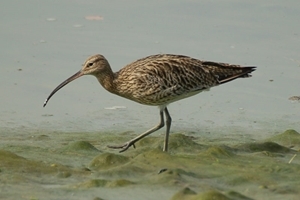 The curlew is easily recognisable by its impressive size and long, curved beak. Although it is a similar size to a pheasant, it has very long legs. They make a very distinctive, eerie call. The curlew is globally threatened, especially in the UK, with breeding populations declining rapidly, meaning the curlew is on the RSPB Red list. It is argued to be the most pressing bird conservation priority in the UK. Curlew live across the UK on farmland, coastal areas and heathlands, but they are classed as waders, meaning they like to wade in shallow, often muddy waters for food, digging deep with their beaks for invertebrates.
The curlew is easily recognisable by its impressive size and long, curved beak. Although it is a similar size to a pheasant, it has very long legs. They make a very distinctive, eerie call. The curlew is globally threatened, especially in the UK, with breeding populations declining rapidly, meaning the curlew is on the RSPB Red list. It is argued to be the most pressing bird conservation priority in the UK. Curlew live across the UK on farmland, coastal areas and heathlands, but they are classed as waders, meaning they like to wade in shallow, often muddy waters for food, digging deep with their beaks for invertebrates.
Little is known of the curlew’s habitat and life, so research is being carried out to find out more in an attempt to save these beautiful birds. More information and how you can support this work can be found here.
Lapwing
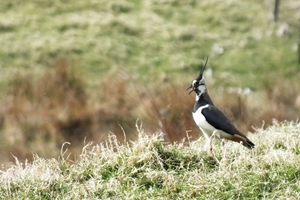 The lapwing or ‘peewit’, as it is also known, is a beautiful bird – look at the colours on its back and its impressive quiff!
The lapwing or ‘peewit’, as it is also known, is a beautiful bird – look at the colours on its back and its impressive quiff!
In winter they can be seen in big flocks, wheeling around in the sky with their rounded wings and distinctive call, ‘peeewit’, making the lapwing a firm favourite to see over farmland and moorland. During the nesting season they then move to lowlands. They are ground-nesting birds, making them vulnerable to nest raids from small mammals and aerial attacks from corvids (e.g. crow, jackdaw and magpie). Lapwing populations are in decline and, as such, they are on the RSPB Red list.
Snipe
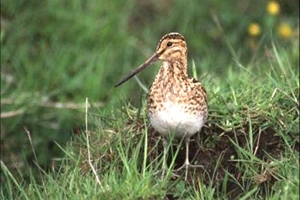 With their darker upper bodies and paler tummies, they are more likely to be seen in the air, as they live in marshes they are hard to see unless in flight. When flying they roll from side to side as though they are zig zagging through the air. In spring snipe will do a display known as ‘Drumming’ they have two feathers on their tail which vibrate when the bird drops through the sky from height, making a sound similar to a voovoozela or kazoo. Look at its very long beak in comparison to its body length, very useful for digging for delicious invertebrates and worms.
With their darker upper bodies and paler tummies, they are more likely to be seen in the air, as they live in marshes they are hard to see unless in flight. When flying they roll from side to side as though they are zig zagging through the air. In spring snipe will do a display known as ‘Drumming’ they have two feathers on their tail which vibrate when the bird drops through the sky from height, making a sound similar to a voovoozela or kazoo. Look at its very long beak in comparison to its body length, very useful for digging for delicious invertebrates and worms.
Woodcock
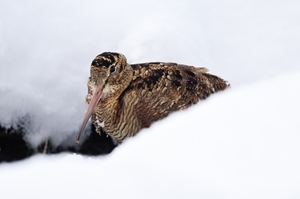 With its very long tapered bill but relatively short legs, the woodcock is adapted to living in woodland and surrounding farmland and has camouflaged plumage, making it virtually impossible to see among fallen leaves on the woodland floor. Because it is largely nocturnal, we know very little about this strange species, other than the fact that the resident population is greatly increased when more than 700,000 birds come to Britain for the winter from the continent. Due to falling populations and decline in breeding birds the woodcock is on the RSPB Red list.
With its very long tapered bill but relatively short legs, the woodcock is adapted to living in woodland and surrounding farmland and has camouflaged plumage, making it virtually impossible to see among fallen leaves on the woodland floor. Because it is largely nocturnal, we know very little about this strange species, other than the fact that the resident population is greatly increased when more than 700,000 birds come to Britain for the winter from the continent. Due to falling populations and decline in breeding birds the woodcock is on the RSPB Red list.
Read about the GWCT tagging of woodcock here.
Photo credit: Laurie Campbell
Golden plover
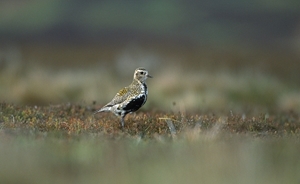 In the spring, the golden plover has a finely speckled back and top of the head with black underneath. In the winter, they moult to become more golden across their whole body. Like many waders, they can be seen in the uplands throughout the breeding season before heading to lowlands and coastal areas for the winter. Golden plover can fly at speeds up to 60mph, especially when protecting their nests, which are small scrapes on the ground. On average four eggs are laid, and both male and female birds sit on the nest.
In the spring, the golden plover has a finely speckled back and top of the head with black underneath. In the winter, they moult to become more golden across their whole body. Like many waders, they can be seen in the uplands throughout the breeding season before heading to lowlands and coastal areas for the winter. Golden plover can fly at speeds up to 60mph, especially when protecting their nests, which are small scrapes on the ground. On average four eggs are laid, and both male and female birds sit on the nest.
Photo credit: Laurie Campbell
Oystercatcher
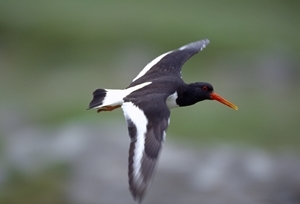 You will recognise the squawk of the oystercatcher as it flies overhead, often in small groups but sometimes on their own. With their bright red-orange beak, red-pink legs and black and white body, they are easy to recognise. Oystercatchers are found across the country from the coast to farmlands; they eat worms inland and cockles and mussels on the coast, where you can sometimes see them drop their bounty from high in the sky onto rocks in order to break the shell and extract the meat. They nest on the ground so their nests and chicks are susceptible to invasion. If you are lucky enough to see them nesting or young chicks running around, it is best to give them space as the parent birds can dive bomb you in an attempt to protect their young!
You will recognise the squawk of the oystercatcher as it flies overhead, often in small groups but sometimes on their own. With their bright red-orange beak, red-pink legs and black and white body, they are easy to recognise. Oystercatchers are found across the country from the coast to farmlands; they eat worms inland and cockles and mussels on the coast, where you can sometimes see them drop their bounty from high in the sky onto rocks in order to break the shell and extract the meat. They nest on the ground so their nests and chicks are susceptible to invasion. If you are lucky enough to see them nesting or young chicks running around, it is best to give them space as the parent birds can dive bomb you in an attempt to protect their young!
Photo credit: Laurie Campbell